OK.. Vanitas....
'vanitas is a type of symbolic work of art especially associated with Northern European still life painting in Flanders and the Netherlands in the sixteenth and seventeenth centuries, though also common in other places and periods. The word is Latin, meaning "emptiness" and loosely translated corresponds to the meaninglessness of earthly life and the transient nature of vanity.'
(http://en.wikipedia.org/wiki/Vanitas - 01/10/2010)
There are several traditional symbolic elements used Skulls are used to represent certain death, Bubbles show the fragility of life.. Rotting fruit represents Decay, whilst clocks show the passing of time.
Let's have a look at a couple of examples...
Cornelis De Heem - Vanitas Still Life with Musical Instruments c.1661

http://www.wga.hu/html/h/heem/cornelis/v…


'The artist belonged to the second generation of the famous dynasty of still-life painters. He spent his youth in Leiden and as demonstrated by this work, he established close connection with the Leiden school of painting.
This splendid painting invokes the memory of the golden age of Dutch still-life painting. The sumptuousness of the instruments is especially fascinating. Most prominent among them is the six-stringed, inlaid viola da gamba leaning against the chair, with a lion's head for decoration and an "S" shaped sound hole (more characteristic of violin). Next to it on the ground are two types of lutes, a trumpet, a flute and a mandolin; in a chair on the left, a violin, a bagpipe and a small pocket violin.
On the table, richly laid with fruits and golden objects, are the traditional symbols of Vanitas. To illustrate the transitoriness of pleasures gained from wealth, plentitude and eating and drinking, there is an up-ended wine jug from which its content have spilled onto the ground, symbolizing that earthly pleasure is short-lived and man will return to dust. In this context the instruments are symbols of physical love. Next to them the painter depicted a snail on the ground. It was generally believed that this animal was born of mud, thus it became the symbol of sin. In contrast, the ivy crawling up the wall in the background promises immortality. The peach, melon and fig, since they are cut open and their seeds are revealed, symbolize reviviscence and resurrection. This image make the message of the painting less somber, although its warning intent is unmistakably recognizable."
The musical instruments also represent the pleasure of music and it's transience, a metaphor for the impermanence of life's pleasures. '
(http://www.wga.hu/frames-e.html?/html/h/heem/cornelis/vanitas.html - 01/10/2010)
Another example is Harmen Steenwyck
Harmen Steenwyck (1612 - 1656)
Vanitas Still Life Painting
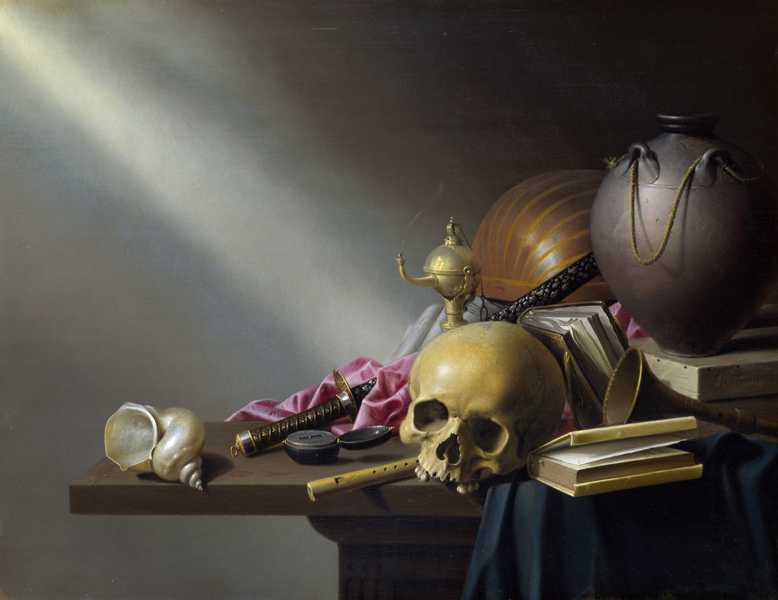
Still Life: An Allegory of the Vanities of Human Life
(oil on oak panel, 1640)
The National Gallery, London
'Still Life: An Allegory of the Vanities of Human Life' by Harmen Steenwyck is a classic example of a Dutch 'Vanitas' painting. It is essentially a religious works in the guise of a still life. 'Vanitas' paintings caution the viewer to be careful about placing too much importance in the wealth and pleasures of this life, as they could become an obstacle on the path to salvation. The title 'Vanitas' comes from a quotation from the Book of Ecclesiastes 1:2, 'Vanity of vanities, all is vanity.'
The Symbolism of the Objects
The objects in this painting have been chosen carefully to communicate the 'Vanitas' message which is summarized in the Gospel of Matthew 6:18-21: “Do not store up for yourselves treasures on earth, where moth and rust destroy, and where thieves break in and steal. But store up for yourselves treasures in heaven, where moth and rust do not destroy, and where thieves do not break in and steal. For where your treasure is, there your heart will be also." Each object in the picture has a different symbolic meaning that contributes to the overall message:

The Skull

The Shell

Books and Musical Instruments
The books represent the range of human knowledge, while the musical instruments suggest the pleasures of the senses. Both are seen as luxuries and indulgences of this life.

The Silk and the Sword
The purple silk cloth is an example of physical luxury. Silk is the finest of all materials, while purple was the most expensive colour dye.
As a symbol, the Japanese Samurai sword works on two levels. It represents both military power and superior craftsmanship. These razor edged swords, which were handcrafted to perfection by skilled artisans, were both beautiful and deadly weapons.
The Stoneware Jar
The Composition of the Objects
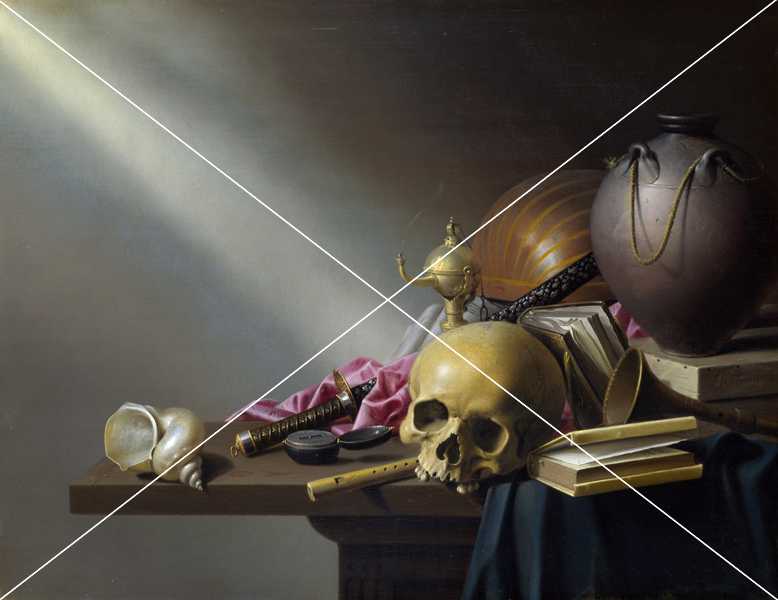
The composition of the work also amplifies the still life's symbolic meaning. In our illustration you can see how Harmen Steenwyck has used the diagonals of the painting to construct its arrangement. The objects which represent the 'Vanities of Human Life' fill the lower half of the work which is split by a diagonal. The absence of form in the upper half represents our spiritual existence. This is an empty space into which we can project our beliefs and ideas as to what this means. In this space a beam of light, which descends on the opposite diagonal, establishes the dramatic tone of the work and symbolically suggests the link between this life and the next. This beam also has two practical functions within the composition: it illuminates the skull and acts as a counterbalance to the triangular arrangement of objects in the lower section.
The Painting Technique

Steenwyck employs a very impressive painting technique to give the still life a vivid sense of realism. Using small brushes, he paints the image on an oak panel which is primed and sanded to form a glass smooth ground. By building up the picture with thin glazes of oil paint he manages to realistically convey the wide range of textures that the individual objects possess: the iridescence of the shell, the translucence of bone, the softness of leather, the smoothness of silk, the reflections of metal, the coldness of stoneware, the roughness of rope and a variety of wood surfaces that range from a gloss varnish to a dull matt.
The assorted forms and textures of the objects are unified by the limited palette of tertiary colours that Steenwyck selects. These subdued colours are chosen because the overall arrangement of objects is too complex and their textures are too refined to support a bolder colour composition. To counteract this subtlety he adds a sense of drama by highlighting each object with exaggerated tone.
The Development of Dutch Still Life
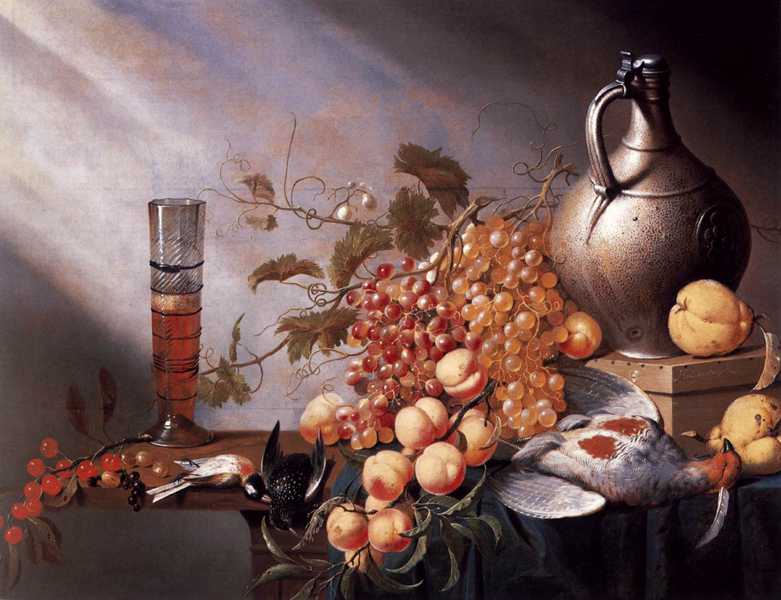
Harmen Steenwyck - Still Life with Fruit and Dead Fowl
(oil on canvas, 1630)
Private Collection
In seventeenth century Holland, still life grew in popularity as a subject due to the Reformation. In the previous centuries artists had found patronage in the creation of religious imagery for the Catholic Church, but as this support declined, they had to adapt to survive in the new Protestant climate. Still lifes using symbolic images that reflected Protestant attitudes found favour and patronage from the Dutch merchant classes. The character of different towns is even reflected in their choice of symbolic objects. The university town of Leiden, where Harmen Steenwyck studied art under his uncle David Bailly, preferred skulls and books, whereas the Hague, a market centre, favoured fish with its traditional Christian associations, while many others used flowers, another Dutch product.
The Vanitas Influence
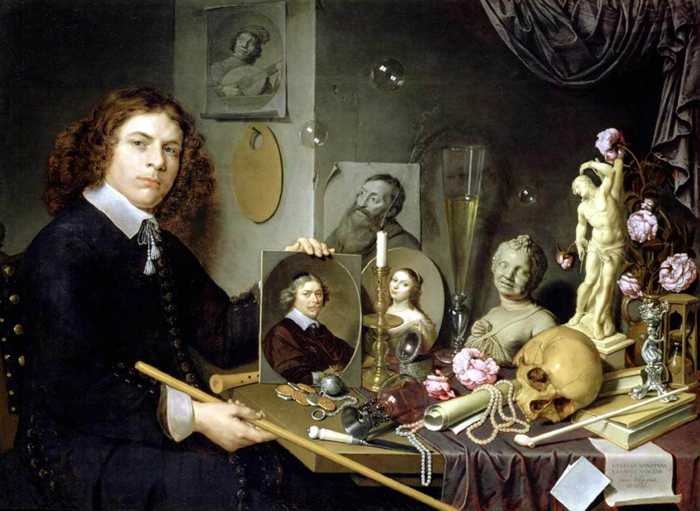
David Bailly (1584-1657)
Self-Portrait with Vanitas Symbols (oil on wood panel, 1651)
Stedelijk Museum De Lakenhal, Leiden
David Bailly was Harmen Steenwyck's uncle and teacher. You can see his influence through the choice of subject matter in his painting below. This is a self portrait of Bailly with a full range of 'Vanitas' objects. The painting depicts Bailly as a young man holding a contemporary self portrait - he was in his sixties when he painted the work. This gesture fuses together portraiture and still life into the one 'Vanitas' concept.
The Vanitas Flaw
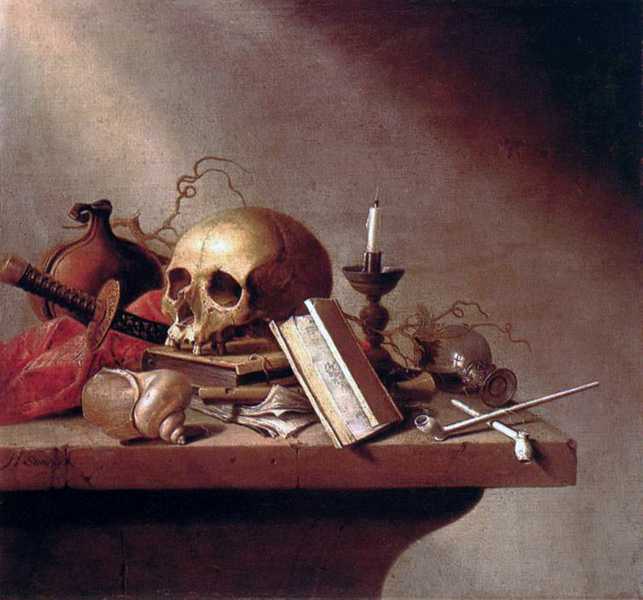
Harmen Steenwyck - Vanitas
(oil on wood panel, 1640)
Stedelijk Museum De Lakenhal, Leiden
Vanitas paintings were popular in countries with strict Protestant and Catholic Christian principles such as Holland and Spain. They were purchased by the rich who possessed a conscience about the wealth they had accumulated. However the genre had an inbuilt weakness in the irony that the paintings were also valuable and collectible commodities and, as such, became 'Vanitas' objects themselves.
Harmen Steenwyck Notes

Harmen Steenwyck - Still Life (oil on canvas)
Private Collection
- Harmen Steenwyck was a Dutch 'Vanitas' painter.
- 'Vanitas' paintings were warnings that you should not be concerned about the wealth and possessions you accumulate in this world as you can't take them with you when you die.
- Vanitas still lifes depicted objects that had a symbolic meaning: a skull as a symbol of death, a shell as a symbol of birth or books to represent knowledge.
- Harmen Steenwyck was from the university town of Leiden where artists often used skulls and books as 'Vanitas' objects. You can recognise works from other towns by their specific selection of symbolic objects.
- Harmen Steenwyck paints his images with incredible realism and astonishing skill. This realism is meant to enhance the truth of the 'Vanitas' message.
- Ironically the 'Vanitas' style had an obvious inbuilt weakness: the paintings were expensive collectable commodities and as such became Vanitas objects themselves.
(http://johnmactaggart.com/art_appreciation/still_life/steenwyck/harmen_steenwyck.htm - 01/10/2010)
Ok.. that's enough for part one... More later.

No comments:
Post a Comment